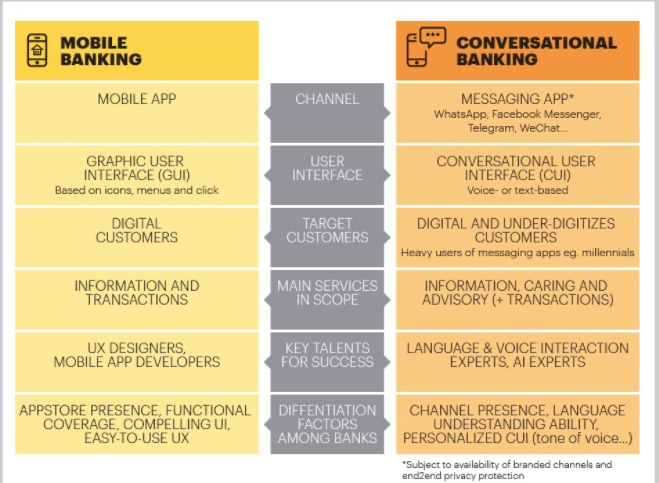 |
submitted by /u/nikitaljohnson [link] [comments] |
Category: Chat
-
The Conversational AI and NLP Summit takes place later this month. See the speaker list and agenda below! Speaking companies include Deepmind, Facebook and more.
-
Chatbot + Airtable / Transfering data from a chatbot
We have created this tremendous chatbot, that would subtly ask for user information that is required in a form and add it to a customer base. It can do this consistently 24*7.
It integrates with your instance of Airtable, picks the base in which you want to add those details too.
Want to give it a try? Try for free
submitted by /u/mihircontra20
[link] [comments] -
The need for Chatbots in Banking in a post-COVID-19 world
Banks, which have typically had a heavy offline interaction with customers, today, face challenges to business continuity as employees are stranded in various locations with uncertain return dates. Apart from this, dramatic changes in customer demand are putting banks under huge stress: sharp declines in demand present serious financial challenges to many businesses, while those facing demand surges and resource shortage risk disappointing and disengaging customers. COVID-19 has disrupted operations and will have prolonged impacts on continuity of operations, modes of working, and growth patterns. CIOs need to respond to the crisis with both short- and long-term actions to increase resilience against future disruptions and prepare for rebound and growth.
Banks have long had on their agenda to streamline and automate processes. The Banks who were leaning more towards cost-saving were exploring RPA for automation of administrative processes and those banks which were cash-rich and were looking to better their customer experience were looking towards Conversational AI to make workflows more efficient. And in times like these, the best of business continuity plans and sustainability forecasts have fallen short of making predictions for a global lockdown and disruption.
Let’s walk through the challenges faced by the banking industry and a few solutions to undertake for the short-term and long-term.
Digital transformation challenges faced by banks:
One of the biggest challenges top executives at banks face is the gamut of transformation required. From internal processes to customer-facing processes, all areas require digitization and automation.
As per the research done by our Analyst partner Gartner, data-driven technologies are still seen as a game-changer, but many banks are perplexed on how to move forward?
The 2020 Gartner CIO Survey asked banking IT leadership to identify which technology capabilities they see as crucial to their organization’s evolution. For the 2020 survey, data analytics, and artificial intelligence (AI) were at the top of the list and roughly equal for financial services CIOs (see Figure 1).
Figure 1: Game-Changing Technologies
Figure 1 Source: Gartner During the last few years, there has been much discussion about how customer engagement in banking can better serve and provide new product opportunities to customers, considering all the points of engagement offered by banking institutions. Often-used buzzwords like “omnichannel” or “multichannel” have punctuated this discussion. Often, however, banks find that they are unable to digest and analyze customer data and transactions well enough to support the user interface or customer journeys.
Trending Bot Articles:
1. How Chatbots and Email Marketing Integration Can Help Your Business
Challenges faced by bank’s agents and employees:
With business continuity completely disrupted, employees are finding it hard to run the business as usual, for processes that were offline and even for the processes that were online.
Various quarantine measures and travel limitations undertaken by different Countries and cities have created big uncertainty around employees’ return to work dates. Even returning employees are often asked to self-quarantine for seven to 14 days. Internationally, indefinite travel restrictions by many countries are causing similar uncertainties to business operations. Operations have either been suspended or run on a limited capacity. Since the outbreak, demand for digital collaboration tools has skyrocketed as organizations are deploying these tools so that employees can work remotely.
Challenges faced by the bank’s customers:
Customers today are more available on conversational channels such as messaging apps and IoT devices. Whereas banks have successfully transitioned to mobile banking and app-based banking.
Where banks are focussing on icons, menus, and clicks; users have moved to expect a conversational user experience on voice and chat. Where banks are focusing on transactional coverage, customers are expecting transactional, service-related, and even advisory services to be made available, on the channels of their choice.
In Figure 2, Gap between Mobile Banking and Conversational Banking.
Figure 2. Source: Accenture Conversational Banking Insight How can Conversational AI help banks drive business continuity and growth?
Conversational channels have the potential to help banks solving this customer interaction conundrum, capitalizing on three major consumer and technological trends:
Trend #1 Messaging is now the preferred customer touchpoint
Messaging apps are now the dominant form of mobile interaction, enabling easy, fun interactions on the move. Their simple, intuitive text or voice-based interfaces are loved by Millennials, as well as by consumers typically more reluctant to embrace digital channels too. They’re also AI-ready, offering easy integration with chatbots and cognitive agents.
Trend #2 AI is becoming ready for B2C
As AI continues to develop, bots are becoming more human-like in their interactions, and can now be built with self-learning capabilities. That enables not only the automation of repetitive customer care tasks but also low-value advisory services.
Trend #3 Mass personalization and liquid expectations
By leveraging new data-driven insights, companies are able to offer unmatchable customer experience and personalized digital services at a mass level. This creates competition across, as well as within industries, as customers’ “liquid expectations” means each digital interaction is expected to be as good as the best last experience, regardless of brand or industry.
#1 Solution: Conversational AI for Agents in Banking:
Using Yellow Messenger’s service desk automation, you can leverage the true power of AI by closing the automated-learning loop between humans, platforms, and bot. Empower your agents to do more with less at hand, by:
a. Providing agent assistance:
Using conversational AI, you can enable your agents to be highly efficient by enabling access to customer sentiment and the past context of the conversation. Integration with CRM and service desk backend tools enables the bot to show relevant data like past case references, customer history, and journey map. Agent assist feature searches for past resolutions by agents for similar queries to provide recommended responses which can be audited by the agents and sent across without typing a single letter. Entire agent workflows can also be automated and triggered by the bot on behalf of the agent at the click of a button.
b. Live Agent Transfer: Deploy Virtual Assistants to be the first line of respondents and take the load off ~65% queries which are standard, and only handoff to a live agent the queries that really need their input. Cognitive agent routing capabilities ensure that each ticket gets assigned to the most relevant agent-based on concurrency, ticket details, agent availability, past conversations, and several other factors. Agents can either chat with the customers or use voice and video calling capabilities to resolve issues on call. Our intelligent queue management allows you to manage and allocate ticket flow even when agents are offline. The service desk can be customized to show relevant data using integrations with your CRM, IT requests and support systems and is available as a mobile app for agents who do not have access to laptops at home.
#2 Solution: Conversational AI for Customers in Banking:
The implications of conversational AI in banking are far-reaching, especially when it comes to Customer Experience. Here’s how Virtual Assistants can help Banks enrich their customer experience:
a. Banking Virtual Assistant: Virtual assistants can provide a personalized banking experience, on-demand, across channels like Web, App, Messaging, Voice, and more. These virtual assistants can help answer FAQs and even take the role of advisory and upsell products that are more likely to be appreciated by the customer.
b.Contact Centre Automation: No more long wait times on calls. No more repeating your query at multiple handoff points. With IVR automation, customers can reap the benefit of being served in less than 1 minute and banks can enjoy cost and experience efficiencies.
Summary:
Conversational AI in banking is a necessity to drive business continuity at customer and employee end. For more information, visit: https://yellowmessenger.com/
Don’t forget to give us your 👏 !



The need for Chatbots in Banking in a post-COVID-19 world was originally published in Chatbots Life on Medium, where people are continuing the conversation by highlighting and responding to this story.
-
How Alexa Education Skills can Help You Learn New Things
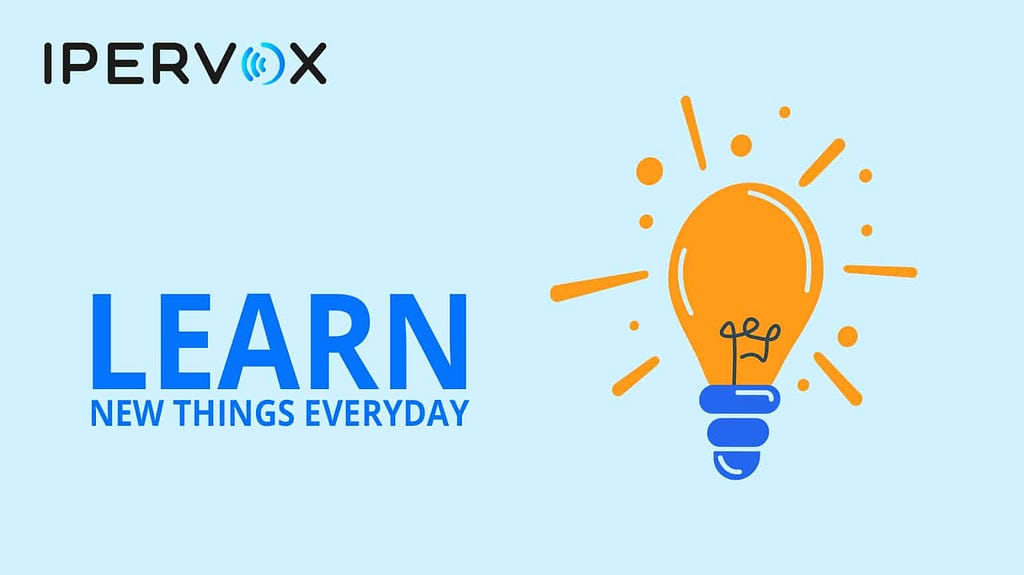
Nowadays there are more than 120 000 Alexa Skills available for everyone. Considering this, it’s a bit difficult not to find one that can help you learn new things. Even if your interest to learn goes for less popular topics. Probably there are Alexa learning Skills that can help you gain new information.
Amazon Alexa is attracting more and more attention lately. This has made it a launching point for many industries. Be it for pure entertainment or for more technical ones, everyone is rushing to have their Skill published.
All of this with the intention of making their presence in the voice world, a new market opens for everyone.

How to learn new things with Voice Applications
Using a smart speaker, like Amazon Echo, to learn new things might seem kind of strange. However, every Skill has been built with the intention of offering a plausible experience for every user.
First, let’s clarify what Voice Applications are
-
What are Voice Applications?
Voice Applications are similar to applications you use on your smartphone. They can offer an experience similar to visiting a website online to receive a certain information, or to interact with others.
These Voice applications, called so for the simple fact that you control them using only your voice, when referring to Amazon Alexa are called Skills.
If you want to find a new Skill, all you need to do is go to the Alexa Skill Store. There you can do a simple search with certain keywords or search by category.
Trending Bot Articles:
1. How Chatbots and Email Marketing Integration Can Help Your Business
Amazon Alexa Learning Skills
There are already plenty of different Skills to learn from. You can find Skills to help you Meditate, teach you historical facts and events, learn soft skills, and how to make something with step-by-step instructions.
- For example, a great way to learn how to do something is the wikiHow Skill. It has over 180 000 articles accessible from everyone. From soft skills to practical and technical ones, it can be really helpful.
- If you need a guide on how to meditate you can try Real Simple Relax or a Guided Meditation from Headspace and take you first steps towards meditation.
- In case you want to learn new facts by testing yourself, you can try Question of the Day and start everyday with a challenge.
What about the Kids?
When it comes to kids and teens, there are thousands of Skills available. They help kids to be entertained or help them with their homework. With it, they can learn new facts, play games, storytelling, learn new languages.
They are a great way to have your kids learn new skills, listen to different stories and audiobooks for their age. Also, they can learn new words, and develop their practical skills (math, physics, etc.)
Don’t forget to give us your 👏 !



How Alexa Education Skills can Help You Learn New Things was originally published in Chatbots Life on Medium, where people are continuing the conversation by highlighting and responding to this story.
-
What are Voice Applications?
-
Review Analysing Application using NLP — Part 1
Review Analysing Application using NLP — Part 1

In my previous article, I talked about how machines communicate with humans. In there, I have mentioned the NLP — Natural Language Processing. NLP did a significant role in communication with computers and humans. Today I am going to implement a Simple Review Annalysing Application using NLP and python. I used PyCharm IDE for coding.
Review Analysing Application is a Text Classification application. This article has four sections. they are
- Import dataset
2. Cleaning dataset
3. Create bag_of_words Model
4. Create a Classification Model
5. Test Accuracy

1. Import the dataset
#CSV dataset vs TSV dataset
CSV means Comma-Separated Values, and TSV means Tab-Separated Values. Simply if the dataset is in .csv format, the values in the dataset are separated by comma(“,”). If the dataset is in .tsv format, the values in the dataset are separated by a tab. Usually, for NLP, we are getting .tsv form. Because in NLP, we are dealing with sentences. In sentences, there have most commas. See the example text,
Loved it...friendly servers, great food, wonderful and imaginative menu.
In this example, we have more commas. So if we used .csv, the separated values might be incorrect. But in here no tabs. Therefore we usually get the dataset format .tsv for the NLP.
#Importing the dataset
import pandas as pd
# Importing the dataset
dataset = pd.read_csv('DataSet/review_dataset.tsv', delimiter ='t', quoting = 3)To import the dataset, I used pandas library’s read_csv function. I set the delimiter as tab because the dataset is in .tsv format. And also, I set quoting to 3 because I want to ignore double quotes also.
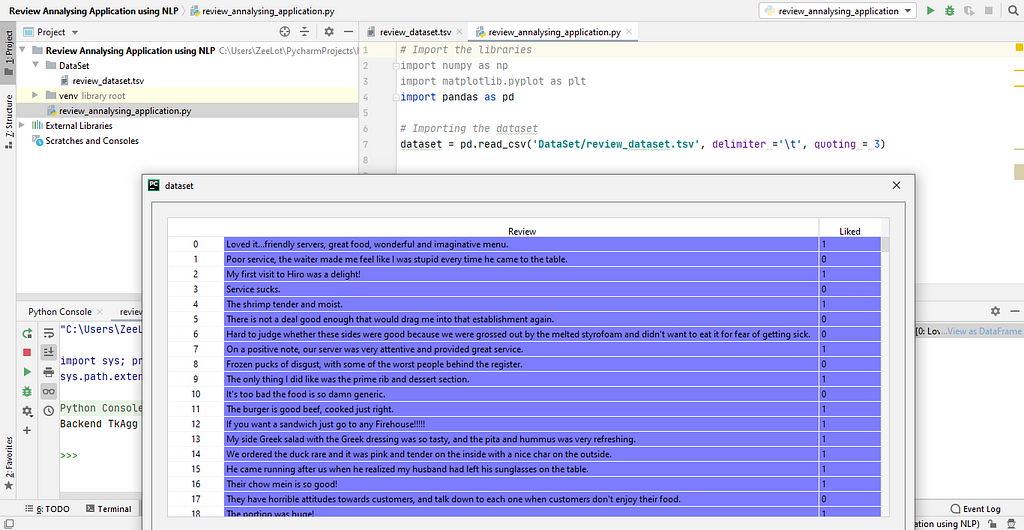
fig 1 — After importing the dataset Here I have 1000 reviews. That dataset has two columns. They are Review and Liked or Not. The review section has the String text given by someone. And Liked or Not section has a Boolean value about his satisfaction.
Trending Bot Articles:
1. How Chatbots and Email Marketing Integration Can Help Your Business
2. Clean the dataset
Firstly I clean one review. And then I apply that method to all reviews.
# get one review
review = dataset['Review'][0]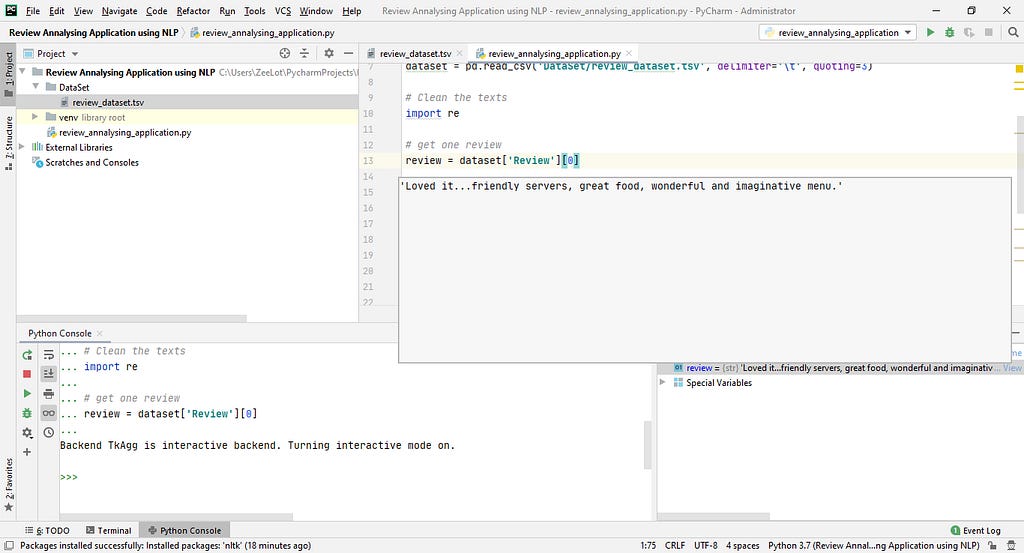
fig 2 — After getting one review For clean the reviews, I use a library called re.
# Remove all things except letters
For the review analysing I want only words. I don’t want any punctuation marks or any numbers. Therefore I remove all unwanted stuff. And I store that sentence again in the review variable. For that, I used sub function in re library.
# remove all things except letters
import re
review = re.sub('[^a-zA-Z]', ' ', review)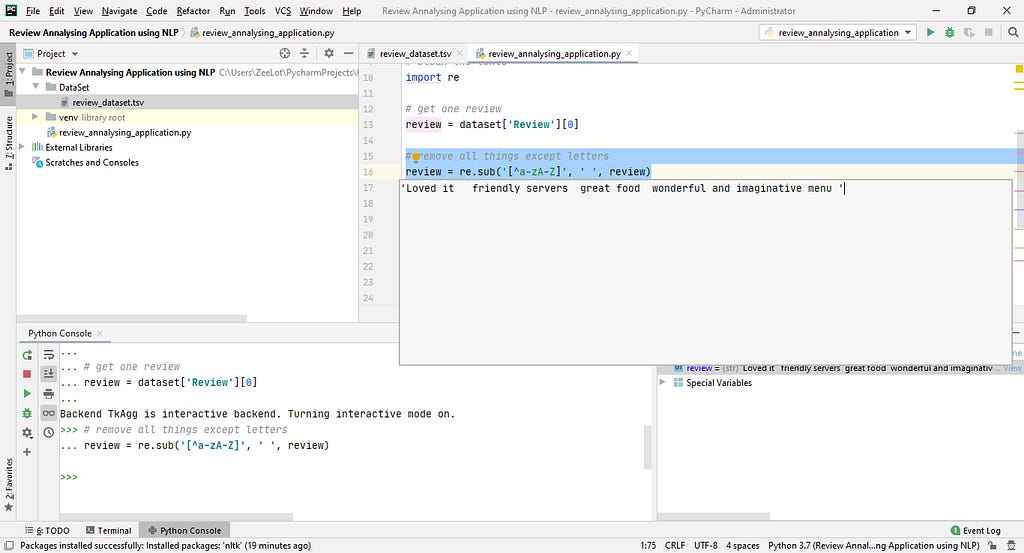
fig 3 — After Remove all things except letters Now you can see there haven’t any punctuations or numbers.
# Set all letters to lowercase
and then I change all letters to lowercase. because I want to number of words in the bag_of_words
# set all letters to lowercase
review = review.lower()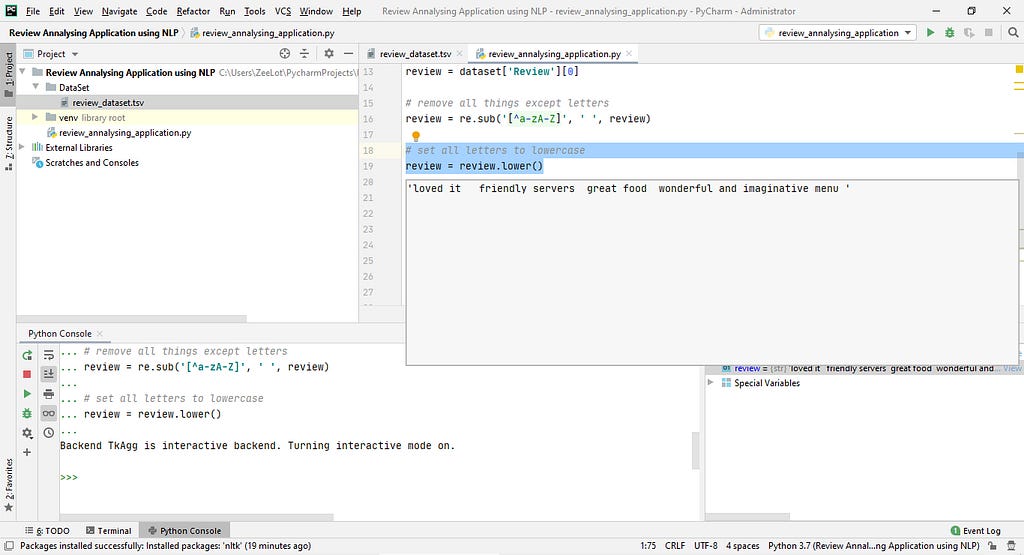
fig 4 — After Set all letters to lowercase # Convert the string to a list
I convert the string value to a list because another step I’m going to remove non-significant words. For that, I use a for a loop. therefore I convert string to a list
# convert the string to a list
review_words = review.split()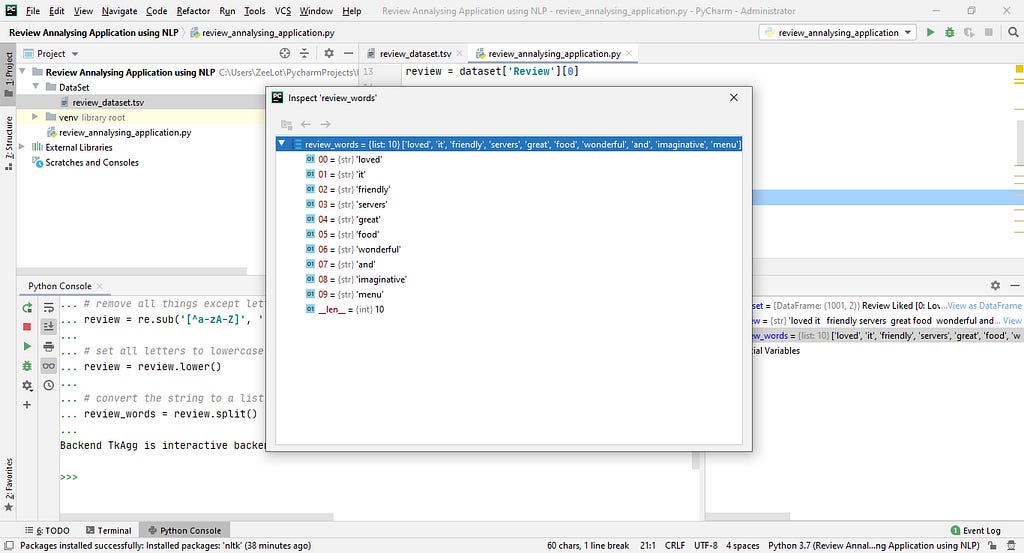
fig 5 — After Convert the line to a list # Remove non-significant words
In the review, there have words to unwanted for the review analysing purpose. Such as I, am, are, this, that… So I also remove those words. For that, I used the nltk — Natural Language Toolkit package. In nltk have a list named ‘stopwords’. Using that word list, I can remove non-significant words.
# remove non significant words
import nltknltk.download('stopwords')
from nltk.corpus import stopwordsreview = [word for word in review_words if not word in set(stopwords.words('english'))]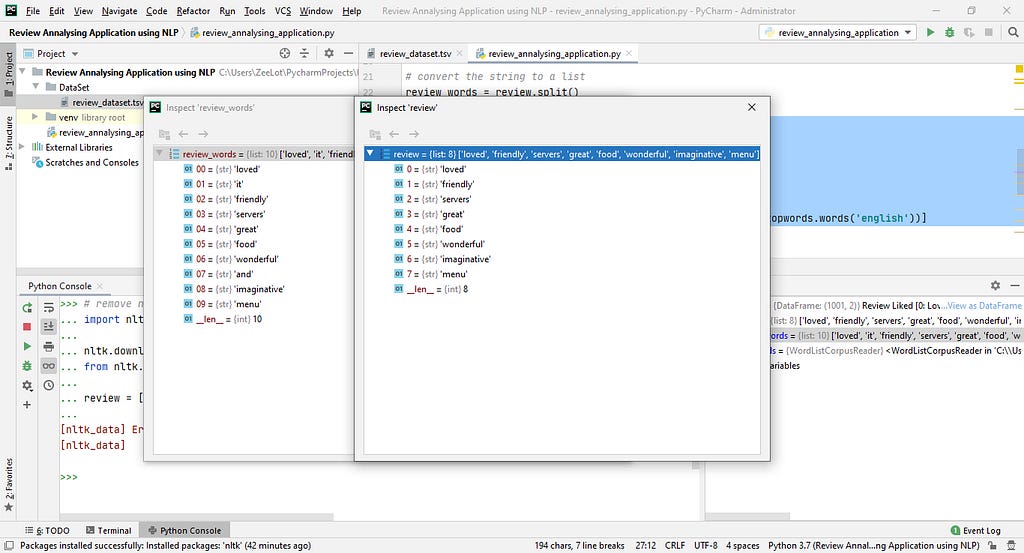
fig 6 — After Remove non-significant words # Stemming => taking the root of the words
we are ding stemming because we want to remove unwanted words from the bag_of_words. Directly stemming means taking the origin of the word. As an example, I get a sentence,
Loved it...friendly servers, great food, wonderful and imaginative menu.
In this sentence have a word named ‘loved’. But this is not the root of that word. The origin of that word is ‘love’. ‘love/loved/loving’ these all words are given the same sense about the review positive or negative. Therefore we don’t want those all words. We can use only the root word for that. If we use the origin word only, our bag_of_words also will be small. We use stemming to reduce the number of words in the bag_of_words.
Simply we,
loved/loves/loving/love => love
for that, I used PorterStemmer in nltk.stem.porter library.
# stemming => taking the root of the words
from nltk.stem.porter import PorterStemmerstemmer = PorterStemmer()
def stemming(word):
return stemmer.stem(word)review_after_stemming = [stemming(word) for word in review]
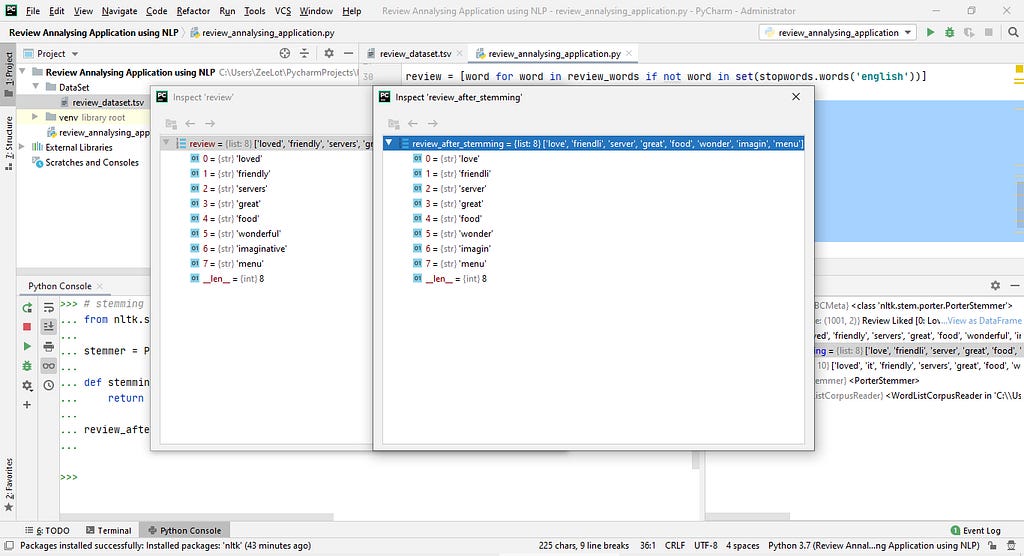
fig 7 — After Stemming # Convert list into a string
Now the cleaning process is over. Therefore I again convert that list to a string.
# convert list into string
review = ' '.join(review_after_stemming)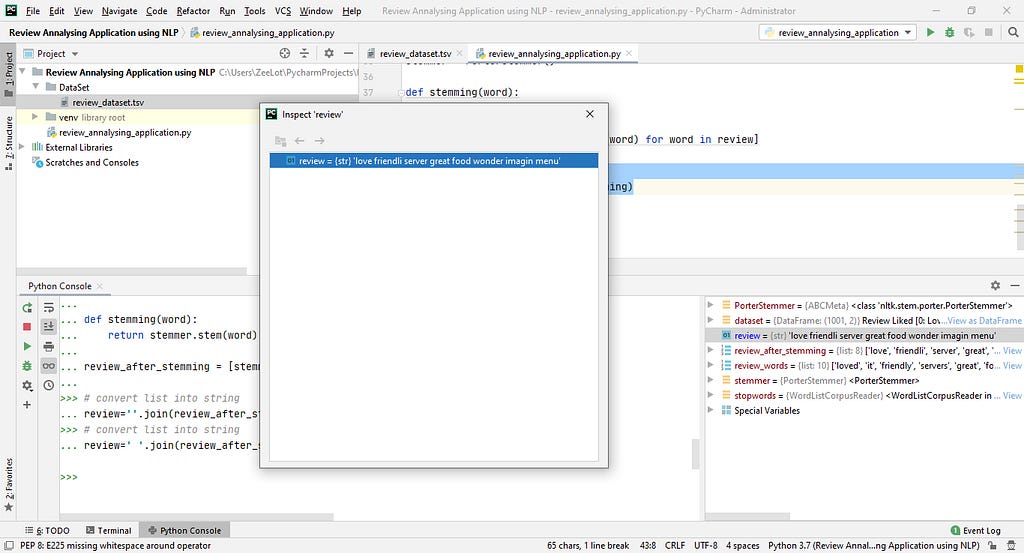
fig 8 — After Convert list into a string # Doing this method to all reviews
Now I’m doing that cleaning process to all reviews.
# doing this method to all reviews
corpus = []
for i in range(0,1000):
review = dataset['Review'][i]
review = re.sub('[^a-zA-Z]', ' ', review)
review = review.lower()
review_words = review.split()
review = [word for word in review_words if not word in set(stopwords.words('english'))]
stemmer = PorterStemmer()
review_after_stemming = [stemming(word) for word in review]
review = ' '.join(review_after_stemming)
corpus.append(review)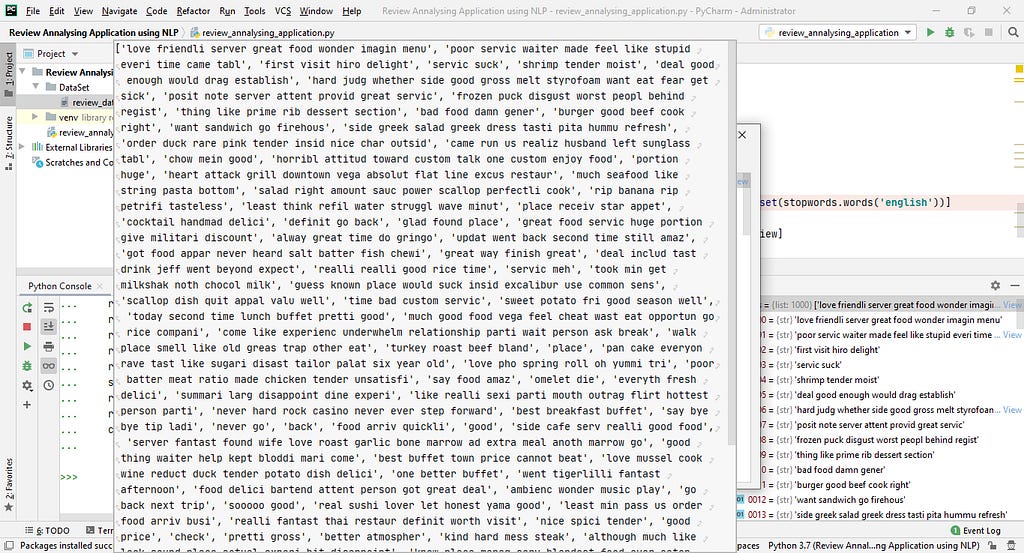
fig 9 — After Cleaning all reviews Now 1 – Import dataset and 2 – Cleaning dataset is done. We will see other sections in Review Analysing Application using NLP — Part 2.
Don’t forget to give us your 👏 !



Review Analysing Application using NLP — Part 1 was originally published in Chatbots Life on Medium, where people are continuing the conversation by highlighting and responding to this story.
- Import dataset
-
Reasons to Use Bot for Telegram

submitted by /u/botpenguin1
[link] [comments] -
DL models to train chatbot
What possible options can I explore for generative models, used to train large datasets for chatbot building. The chatbot has to be built for a large scale website’s support team using python, tesnorflow etc.. . So after the pre processing of dataset, I am confused on how to approach this further. There are various github projects but that has like mixed things up. Google search gives BERT, GPT as possible options. But I need suggestions on how to go about it.
submitted by /u/paw__
[link] [comments] -
How can AI & Chatbots Improve Support Agent Experience & Productivity
With the increased expectation for a speedy resolution and more interactive engagement, customer service representatives (CSR) alone cannot handle the rapidly evolving needs of customer support. An American Express survey found that 78% of consumers have bailed on a transaction because of a lousy service interaction.
As the pressure to scale up processes and deliver quality customer engagements mounts, contact centers witness higher attrition and agent turnover. Hence, to be truly successful in providing exceptional customer experiences, an organization needs to view agent experience, meaning how efficient, empowered, and effective its agents are, as an integral part of its overall customer support strategy.
To augment agent effort, chatbots and other AI-driven technologies are making their way into contact centers. Let’s discuss how a hybrid, co-existential human and AI model improves support agent experience and productivity.
Learn more: https://botcore.ai/blog/chatbots-agent-experience-productivity/
submitted by /u/Sri_Chaitanya
[link] [comments] -
Can Credit card Chatbots double the customer base?
As customer experience becomes one of the primary drivers of growth , banks, and financial services institutions are increasingly looking at innovative technology solutions to simplify customer journeys as a strategic tool for growth. Conversational AI is making a mark as a primary agent of change as banks attempt to increase customer satisfaction while making their processes more efficient.
Conversational agents (Chatbots) have been helping banks save a precious 4 minutes per customer interaction. By 2022, these bots will power more than 90% of all banking interactions, including those related to credit cards. Even now, Credit Card chatbots are powering the entire life cycle of customer use, from application to payments.
Credit Card Life Cycle
Irrespective of the type of business, there are five primary stages of a customer life cycle; reach/awareness, acquisition, conversion, retention, and advocacy. From the perspective of credit card customers, banks/financial institutions and customers need to perform the following activities for each of the above phases;

Reach/Awareness
This stage is where a prospective customer becomes aware of various credit card services by a bank/institute and the benefits a credit card brings to them. To drive home the point, banks can also share special offers for customers to obtain the card.
Acquisition
If the cards’ availability and offers make the customers interested, the next stage is to capture this interest. This interest becomes a lead that banks can then pursue to win over a prospective customer. Banks can ensure the customers’ interests by providing more nuanced information, including each type of card’s benefits. These benefits include rewards and cashback, loyalty programs, and any other incentive a customer gets by availing of the card. Based on this information, the customers would either make a preliminary application or provide the contact information so that a bank can reach out with more details.
Conversion
If the customer is convinced about the benefits and applies for a credit card, the bank needs to get the required document to ascertain the eligibility. Banks also need to calculate the customer’s creditworthiness and ensure there is no fraudulent or inaccurate information. If everything is alright, the banks then issue and activate the card.
Customer retention involves two different aspects for the bank; they need to ensure that they are making profits from the credit card operations while ensuring that they do not go away. From the operational perspective, once the customers start using the card, banks need to keep track of spending and invoice the customers at predefined intervals. They need to send payment reminders until the customers pay. The banks need to conceptualize and convey continued rewards and benefits to the customers on the retention front.
Trending Bot Articles:
1. How Chatbots and Email Marketing Integration Can Help Your Business
One of the critical phases of the consumer life cycle is continued loyalty and advocacy, where the customers become your brand ambassadors and growth agents. This stage is where your loyalty initiatives, including referral programs or enhanced credit limits for better customers, can ensure your customers become your advocates.
Cross-cutting Concerns
Apart from these lifecycle stages, certain events may happen anytime during the life cycle. Primary among them are users losing the cards or defaulting on the payments. In both cases, the banks may have to block the existing cards. Apart from this, there might be customer inquiries, statement requests, or requests related to adjusting the credit limits that can take place anytime.
How Credit Card Chatbots Help Both Banks & Customers
Well-designed chatbots can be valuable tools to serve credit card customers throughout the lifecycle effectively. Not only will they contribute to customer satisfaction, but they can ensure the efficient execution of operations for banks or financial services institutions.
Reach/Awareness
The conversational interfaces (chatbots) can succinctly inform your audience during natural conversations about credit cards you offer and what benefits they bring for the customers. These bots can work with multiple channels, including websites or your apps on mobile devices. These bots can be part of your comprehensive customer service toolkit to provide a consistent experience.
The AI technology powers the bots through natural language processing to identify the right context to introduce your credit card services without being intrusive. Possessing the capabilities of contextual conversations makes compelling for banks from a customer satisfaction point of view.
Contextual Targeting
can gain additional intelligence by analyzing the historical data about spending habits, credit history, transaction history, and many other parameters. By leveraging the intelligence generated through such analysis, you can utilize chatbots to identify the right audience segment that can benefit from credit card products.
By addressing the customer pain points through such behavioral and contextual analysis, banks & FIs can establish a proactive conversational channel. Customers value relevant information rather than random intrusive advertisements.
Such intelligent outreach can also utilize personalization by addressing individual customers’ unique needs and increasing the conversion rates for banks.
Learn more: 9 Best Chatbots in the Financial Services Industry
Acquisition
With chatbots, customers can get increasingly detailed information without too many hassles. Such data can include details about various cards, individual benefits, rewards, and eligibility, all with the natural conversational patterns. Bots can even present personalized information for individual customers to help each customer understand this information efficiently.
The proactive ease of information availability helps increase customer interest in your card product. Once the customer has all the information, they can apply for a specific card through the chat interface.
Conversion
Conversion is a crucial stage from an institution’s perspective as this stage must maintain a balance between customer service and operational efficiencies. Credit card chatbots ensure customer satisfaction by facilitating seamless interactions for customers. Be it uploading the documents by customers or informing them about the outcomes of each process step.
The underlying computer vision and natural language processing algorithms, along with predictive analysis and anomaly detection capabilities, find probable fraudulent documents and risky applications for better scrutiny. Of course, such capabilities rely heavily upon the algorithms having trained with large and accurate datasets. But gradually, these machine learning algorithms become more accurate through self-learning. The can act as conduits of all this information in natural ways between customers and banks.
Credit card chatbots play a vital role in retention, given their capabilities to facilitate proactive interactions with customers. The bots can remind customers about their dues and enable customers to make payments against those dues.
The bots can help convey any probable fraudulent transactions flagged by the underlying algorithms. Quick identification of such transactions helps both banks and customers against threats and risks.
Through the help of predictive analysis using Machine Learning (ML) and Artificial Intelligence (AI) algorithms, the intelligence component of the credit card chatbots can identify customers with higher flight-risk. Banks can then proactively take appropriate retention measures. Proactively taking such measures helps banks ensure higher retention rates.
Advocacy/Loyalty
As the prime drivers of customer satisfaction, conversational credit card chatbots help banks inform customers about loyalty programs and their benefits. They also facilitate customers to utilize those benefits.
Based on spending patterns and payment history, bots can suggest enhanced credit limits for the customers. This way, bots become agents of growth for banks and financial institutions.
Using demographic data and credit card purchase history, credit card companies can offer targeted promotions and deals to customers digitally.
As customer satisfaction increases through such personalized, contextualized, and practice information availability, the customers, in turn, become your ambassadors, recommending your services to others.
Banks can utilize the bots to advise customers on overall financial health management. Rather than customers reading a manual or an article on money management, a chatbot providing personalized financial advice would be a great way to turn a customer into your advocate and ensure long-lasting loyalty.
Cross-Cutting Concerns
can help customers block their lost cards and reapply for the new card. Royal Bank of Scotland’s (RBS) online chatbot “Assist”- earlier called “Luvo”- is an example of how customers can report lost cards and request blocking them .
Bots can also identify non-paying customers and send them reminders about pending payments. Upon non-payment beyond a threshold, the underlying business logic can also block the card.
Banks can also enhance the effectiveness of these bots and entire operations by capturing customer feedback seamlessly.
Fraud Detection
Fraudulent transactions are a significant concern for banks and financial institutions. With bots, banks & FIs can leverage predictive analytics into their existing fraud detection workflows to reduce false positives. Underlying AI capabilities could analyze and score credit card transactions on their likelihood of being fraudulent by assigning a risk probability score, using predictive analysis or anomaly detection.
Predictive analytics algorithms do need extensive training on a large amount of data. However, the training allows the algorithm to understand an acceptable transaction versus a possible fraudulent one. Such training may also discover previously undiscovered fraud methods and start flagging more fraudulent transactions. MasterCard’s “Decision Intelligence,” the fraud-detection solution, is an excellent example of how the power of ML & AI can help detect and possibly prevent a fraudulent transaction.
Learn how AI Chatbot will transform the Mortgage Industry in 2021
What care should you take while using Credit Card Chatbots?
While chatbots help efficient credit card operations and higher customer satisfaction, they need careful consideration and efforts to be effective.
1. You must ensure that you have trained the bot with enough high-quality data. The ML algorithms have better accuracy if they utilize large datasets. At the same time, inaccurate data labeling may result in erroneous inferences by bots. Both of these scenarios may harm customer sentiments.
Such training also determines the questions and queries that the bot can answer. Banks should be careful about including data that represents the entire cross-section of their customer demographics and operations. For example, institutes must train the chatbots in multiple languages that their customers speak to work in a multilingual environment. While some of these requirements may not be critical, thinking about such edge cases can provide you with an edge when it comes to customer delight.
2. You should use it as another channel of communication, not the only one. Your customers should have other options to perform the same operations if they find them more comfortable. For example, many customers may prefer to communicate via email in bits and pieces. Consistent omnichannel experience is critical for better customer satisfaction.
3. Let your customers also choose to talk to a human assistant any time they want. Limiting their options to virtual assistants may prove to be counterproductive.
4. Instead of rolling-out the bot’s capabilities in one go, incrementally releasing facilities help the customer better adapt to them. You can also benefit from customer feedback to provide better options for solving their acute problems. Once they see the benefits, you can then gradually roll-out increasingly complex use cases.
What are the Advantages of a Credit Card Chatbot?
A Credit Card Chatbot can benefit banking institutes in many ways, such as:
- It can reduce the human agents’ workload by automating repeated queries of the new users and customers.
- Enable an experience for your customers using different channels for interaction.
- Stay available 24/7 and during peak hours to answer the repeated queries of customers.
- It can speed up operations and reduce the cost of your operations.
- Educate thousands of users at the same time about loyalty programs, rewards, and special offers.
Given the advantages, the use of chatbots to manage credit card lifecycles is growing fast. Bank of America, a banking and chatbot implementation leader, uses their chatbot, Erica, to serve clients with comprehensive service for their credit card transactions. Many other institutions like JPMorgan Chase and Fargo Wells are using chatbots to help their banking operations increasingly. As the market leaders see the benefits, the rest of the institutions follow the lead.
Check your credit score with this Smart Skill:
With credit card chatbots, banks and financial institutions can ensure better customer interactions and get an intelligent agent contributing to business growth. These automated intelligent agents , through conversational interfaces, offer better targeting by recommending the right product to the right customers. By analyzing customers’ interactions and data, banks can offer customized products to each customer via the . Through personalized communication, banks can ensure better customer relations, ultimately resulting in sustained business growth, and chatbots are vital instruments for that.
Want to develop an Intelligent Virtual Assistant solution for your brand?
Don’t forget to give us your 👏 !



Can Credit card Chatbots double the customer base? was originally published in Chatbots Life on Medium, where people are continuing the conversation by highlighting and responding to this story.


